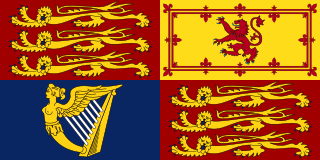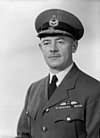Commander is a common naval officer rank as well as a job title in many armies. Commander is also used as a rank or title in other formal organizations, including several police forces. In several countries this naval rank is termed frigate captain.

A commander in chief or supreme commander is the person who exercises supreme command and control over an armed force or a military branch. As a technical term, it refers to military competencies that reside in a country's executive leadership, a head of state, head of government, or other designated government official.

Wing commander is a senior commissioned rank in the British Royal Air Force and air forces of many countries which have historical British influence, including many Commonwealth countries but not including Canada and South Africa. It is sometimes used as the English translation of an equivalent rank in countries which have a non-English air force-specific rank structure. It ranks immediately above squadron leader and immediately below group captain.

Air chief marshal is a high-ranking air officer originating from the Royal Air Force. The rank is used by air forces of many countries that have historical British influence. An air chief marshal is equivalent to an Admiral in a navy or a full general in an army or other nations' air forces.
Commandant is a title often given to the officer in charge of a military training establishment or academy. This usage is common in English-speaking nations. In some countries it may be a military or police rank. It is also often used to refer to the commander of a military prison or prison camp.
The Commander of the Canadian Army is the institutional head of the Canadian Army. This appointment also includes the title Chief of the Army Staff and is based at National Defence Headquarters in Ottawa, Ontario.

Air Marshal George Owen Johnson CB, MC was a Canadian aviator, World War I Flying Ace and a senior commander in the Royal Canadian Air Force during World War II.
The Australian Defence Organisation (ADO) is composed of the armed forces of the Commonwealth of Australia, the Australian Defence Force (ADF), and the Australian Public Service government department, the Department of Defence which is composed of a range of civilian support organisations.

A senior enlisted advisor (SEA) in the United States Armed Forces is the most senior enlisted service member in a unit, and acts as an advisor to the commanding officer. Formally, E-9 billets for the senior enlisted advisor are established at service unit, command, major command, force, or fleet levels to the SEAs/CSELs of DoD Agencies and the Senior Enlisted Advisor to the Chairman of the Joint Chiefs of Staff. SEAs are also known as command senior enlisted leaders (CSEL). Always a non-commissioned officer, the SEA is the main link between the commanding officer and the enlisted service members under his or her charge.

The Navy Command is the current headquarters body of the Royal Navy, and as of 2012 its major organisational grouping. It is a hybrid, neither a command, nor simply an installation. Royal Navy official writings describe Navy Command Headquarters both as a physical site, on Whale Island, Hampshire, a collective formed of the most senior RN officers, and as a budgetary grouping.
Lieutenant-General Joseph Paul André Deschamps, CMM, CD, usually André Deschamps or J P A Deschamps, was Chief of the Air Staff and then Commander of the Royal Canadian Air Force between 2009 and 2012.

Air Commodore Arthur Kellam Tylee OBE was Canadian officer who served in the Royal Flying Corps during World War I. After the War, Tylee was the first Air Officer Commanding of the Canadian Air Force.
The Canadian Air Force (CAF) was the initial, non-permanent peacetime air force formed by Canada after the First World War. When the Air Board was formed in 1919 to manage Canadian aviation, one of its responsibilities was air defence; the CAF was formed to meet this responsibility. The CAF was officially retitled the Royal Canadian Air Force (RCAF) on 12 March 1923, and then dissolved on 31 March 1924 to allow the permanent Royal Canadian Air Force (RCAF) to be formed the following day.

Head of the Armed Forces is the position of the sovereign of the United Kingdom as commander-in-chief of the British Armed Forces. However, supreme military authority has been delegated by the monarch to the Defence Council of the United Kingdom, a body officially charged with the direction and administration of the Armed Forces.

The Commander of the Royal Canadian Navy is the institutional head of the Royal Canadian Navy. This appointment also includes the title Chief of the Naval Staff and is based at National Defence Headquarters in Ottawa, Ontario. This individual reports to the Chief of the Defence Staff, who then responds to the Commander-in-Chief of the Canadian Armed Forces.

General Thomas James Lawson is a retired Royal Canadian Air Force general. Lawson was Chief of the Defence Staff of the Canadian Armed Forces from October 2012 to July 2015. He previously served as Deputy Commander of the North American Aerospace Defence Command.

The Royal Canadian Air Force Ensign is the official flag which is used to represent the Royal Canadian Air Force. The Ensign has an air force blue field defaced with the Canadian Flag in the canton and the current Royal Canadian Air Force roundel in the fly.

Lieutenant-General Michael John Hood is a retired senior Royal Canadian Air Force officer who was Commander of the Royal Canadian Air Force from 2015 until 2018.
Captain is a title, an appellative for the commanding officer of a military unit; the supreme leader of a navy ship, merchant ship, aeroplane, spacecraft, or other vessel; or the commander of a port, fire or police department, election precinct, etc. In militaries, the captain is typically at the level of an officer commanding a company or battalion of infantry, a ship, or a battery of artillery, or another distinct unit. It can also be a rank of command in an air force. The term also may be used as an informal or honorary title for persons in similar commanding roles.

The Presentation of Colours is a military ceremony that marks an anniversary or significant event in the history of a particular regiment or similar military unit. This involves the presentation of a new version of the regimental colour to a regiment or equivalent formation in their respective armed forces service branch. This is a traditional ceremony that was pioneered by the British Armed Forces, and is today used in most Commonwealth countries.







































